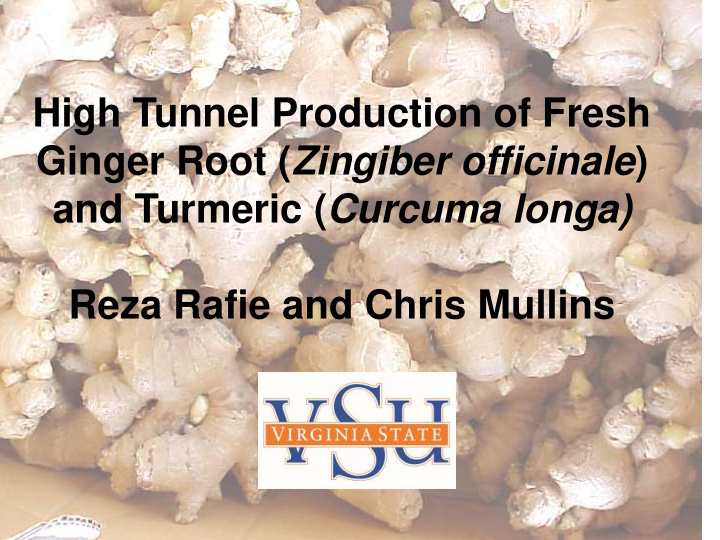



High Tunnel Production of Fresh Ginger Root ( Zingiber officinale ) and Turmeric ( Curcuma longa) Reza Rafie and Chris Mullins
Ginger Seed Rhizomes http://www.ctahr.hawaii.edu/oc/freepubs/pdf/scm-8.pdf: Paul Hepperly and Francis Zee
Ginger Seed-Rhizome - Use only mature, clean, disease-free ginger hands - Cut the selected hands into 2-4 oz sections, sterilizing the knife after each cut - Each seed-piece should have two to four well developed “eyes.” -Surface-sterilize the seed-pieces in a 10% solution of household bleach (1 part bleach in 9 parts water) for 10 minutes -Cure the seed-pieces in a clean, disease-free area for three days or more before planting ( Hepperly, P. and Francis Zee, 2004 )
In April the potted plants are ready to be transplanted in the high tunnel. In February, plant the seed piece in a one gallon pot ½-¾ filled with soilless potting mix (2 parts Compost, 2-4 parts Sphagnum Peat Moss, 1 part Perlite, and 1 part Vermiculite). Maintain in a greenhouse.
May August
September
Fertilizer • Ginger responds well with adequate fertilizer application. • For detail of fertilizer need see • http://www.ctahr.hawaii.edu/oc/freepubs/pdf/SCM-8.pdf
Mounding (Hilling) Is the periodic covering of the upward-expanding rhizomes. It is an important process in ginger production.
Baby Ginger
Mature Ginger Baby Ginger
Armyworm, Pseudaletia unipuncta potential problem with high tunnel ginger production
leaf-spot Phyllosticta zingiberi
Diseases • Bacterial wilt ( Pseudomonas solanacearum ) - wilt of entire plant, rhizome rot. • Bacterial soft rot ( Erwinia sp.) - Leaf, pseudo stem and rhizome rot. • Bacterial leaf blight ( Xanthomonas sp.) - Leaf blight. • Fusarium yellows and rhizome rot ( Fusarium oxysporum f. sp. zingiberi ) - Wilt of entire plant, rhizome rot. • Pythium soft rot ( Pythium graminicola, P. splendens and P. aphanidermatum ): root rot, and soft rot of rhizomes .
Rhizome Rot Fusarium oxysporum
Harvest begun: Field and High tunnel 10/8/2013 Harvest ended: Field, 10/31/2013 and High tunnel, 12/05/2013
Ginger weight per plant (gr.), September 11- October 21, 2015, VSU Randolph Farm 6000 5000 4000 3000 2000 1000 0 1 1 1 1 1 2 3 1 2 1 2 1 2 3 1 2 9/11 9/16 9/23 9/28 10/12 10/12 10/12 10/15 10/15 10/16 10/16 10/19 10/19 10/19 10/21 10/21 Ginger weight (grs.) per plant, October 21-October27, 2015, VSU, Randolph Farm 6000 5000 4000 3000 2000 1000 0 3 4 5 6 7 1 1 2 3 4 1 2 3 4 5 10/21 10/21 10/21 10/21 10/21 10/23 10/27 10/27 10/27 10/27 10/27 10/27 10/27 10/27 10/27
Turmeric weight (grs.) per plant, September 16-October 27, 2015, VSU, Randolph Farm. 4000 3500 3000 2500 2000 1500 1000 500 0 1 1 1 2 1 2 3 4 5 9/16 9/23 10/23 10/23 10/27 10/27 10/27 10/27 10/27
Turmeric, Curcuma longa • Is a rhizomatous herbaceous perennial plant of the ginger family, Zingiberaceae. • It is native in Southeast Asia. Growing turmeric requires 9- 11 month from planting the rhizome seed pieces until the harvest. • In temperate zones as in Virginia, where the growing season is 7-8 month, there is a need to grow turmeric in high tunnel structure
Turmeric
Recommend
More recommend